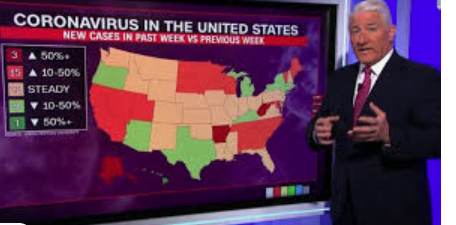


Muddled COVID-19 Messaging: Sometimes the Data Changed; Other Times – Masks, for Example – Your Dishonesty Caught Up with You
It shouldn’t be this hard. The rules of risk and crisis communications are fairly simple:
- Tell the truth.
- Tell it all.
- Tell it first.
- Tell it fast.
- If the situation – or the science – is likely to change as more research is done, warn people ahead of time. And keep repeating that warning.
So why are we mired in this COVID-19 muck? When and why did a virus become political? It’s been said that newspapers contain the first draft of history. Five, ten, twenty or more years from now, will President Trump be the villain? Or will it be the CDC, the WHO – or maybe even Dr. Fauci?
As we so often do, we turn to Dr. Peter Sandman, regarded as one of the country’s premier experts on risk communications.
On July 10, CNN reporter Ivana Kottasova emailed Dr. Sandman asking “about the way public health authorities have been communicating throughout this pandemic.” Below, you can read a portion of that email exchange.
Ivana Kottasová: Why has the message on coronavirus been so muddled? On masks, airborne transmission, social distancing, the WHO and others have seemingly changed their message several times, leaving people confused. Why is that? Are they failing as crisis communicators? Or is it simply that the message evolves as we find out more about this virus?
Peter Sandman: There is no question that COVID-19 messages have to change as the experts learn more about the SARS-CoV-2 virus. And the changes can lead to audience confusion, or even to charges that the experts don’t know what they’re talking about. Crisis communication experts know teachable strategies for ameliorating these problems. To the extent that publics are confused or skeptical about message changes, that is mostly the messenger’s fault.
The most important way to mitigate the downsides of changing your message is emphatically and loudly warning the audience in advance to expect uncertainties, reversals, and even screw-ups. When he was at the World Health Organization, David Heymann did this elegantly during the 2003 SARS epidemic. “We are building our boat and sailing it at the same time,” he said; in plainer English, we’re going to make some mistakes. Jeff Koplan was Director of the U.S. Centers for Disease Control and Prevention (CDC) during the 2001 anthrax attacks and even more poignantly said: “We will learn things in the coming weeks that we will then wish we had known when we started.” The public came to trust Heymann and Koplan not despite these admissions of uncertainty, but because of them.
Emphatically predicting that you’re going to change your mind about some things reduces the reputational damage of changing your mind. That in turn reduces the temptation to hide new evidence and pretend you haven’t changed your mind. I can’t tell you how many conversations I’ve sat in on in that took this form:
“It looks like what’s really happening is Y, not X like we thought.”
“Yeah, but we already said it’s X. If we say now that it’s Y, we’ll lose credibility. People will say we flip-flopped. They’ll say we don’t know what we’re doing.”
“You’re right. I guess we’d better keep saying it’s X.”
Here’s an example I can share, because I know it only from publicly available information. Early in the 2009 swine flu pandemic, the U.S. CDC said that children and young people were the most vulnerable group, and thus should have first priority when vaccines became available. Pretty soon, the CDC learned it was mistaken; the 50-64-year-old age cohort was far and away the most vulnerable. Nonetheless, the agency decided not to change its messaging. It continued to say that children and young people were most vulnerable and most important to vaccinate.
The ideal crisis communication strategy is to emphatically, vividly, and dramatically predict that you will change your mind about some things as you learn more. Half-credit for at least acknowledging your uncertainty in real time. It would have been nice to hear COVID-19 experts say something like this: “We think droplets are the main way the virus is transmitted. But the evidence isn’t definitive. Some transmission has been reported via surfaces (fomites), and also some airborne (aerosol) transmission. Based on the research so far, though, most but not all experts think those two transmission routes are less important than droplets. We are basing our recommendations on that preliminary conclusion. But we promise to let you know as we learn more.”
For the rest, click here.